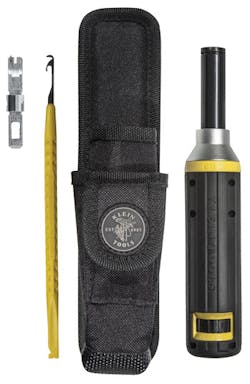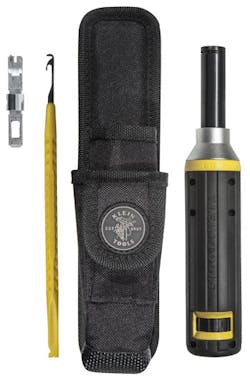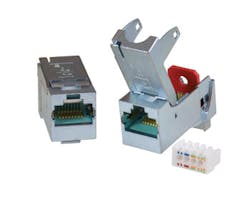Twisted-pair cable termination is an evolving practice
From the June 2015 Issue of Cabling Installation & Maintenance Magazine
Tools have made the termination process easier on many installations, while latest-generation cabling presents challenges anew.
Terminating twisted-pair copper cable is a fundamental-perhaps the fundamental-practice among cabling technicians everywhere. In some ways, twisted-pair termination is the skill by which cabling installers may be measured; that is the case in more than one industry competition. The BICSI Cabling Skills Challenge (www.bicsi.org/skillschallenge/) includes an event titled "Copper Cable Terminations, Firestopping, Grounding and Bonding." Additionally, the Skills Challenge's special speed-based challenge events include a 50-pair punchdown. Separately, the annual Cabling Icon (www.cablingicon.com) contest includes an unshielded twisted-pair (UTP) termination speed trial as its primary skills measurement. As such a fundamental function, the processes and tools for performing terminations are widely recognized and known. And as the cable that is being terminated changes, subtly or significantly, the tools used for those terminations change accordingly.
The punchdown tool can be found in every cabling technician's belt, and is available from a number of suppliers. Platinum Tools (www.platinumtools.com), for example, offers the Pro-Strike Punchdown Tool, which incorporates a built-in hook to feed or remove wire as well as a multi-use spudger that can be used as a screwdriver, an insert tool, or to clean debris. Likewise, Southwire (www.southwiretools.com) introduced the PDTC-1 Comfort Grip Punchdown Tool as part of its wide-ranging tool rollout in 2014. Among the PDTC-1's distinguishing characteristics is its contoured handle, which Southwire explains affords the user a comfortable grip.
In February 2014 Klein Tools (www.kleintools.com) introduced the Cushion-Grip Impact Punchdown Tool and Blade, which as its name indicates, includes a cushion-grip handle. The company says the tool's long shaft enables it to reach into narrow or crowded blocks. When the tool was introduced, Klein's senior product manager Sean O'Flaherty commented, "Most current punchdown tools follow the same traditional, square-based pyramid style that is difficult to maneuver and requires additional accessories to reach into tight spaces. Klein Tools' new punchdown tool naturally overcomes these hurdles with its comfortable screwdriver-shape design that includes a long, narrow shaft that eliminates these limitations and provides easy, precise access to panels and blocks." The punchdown tool and blade are available as part of a kit that also includes a pick/spudger and a pouch.
Jack termination
For more than a decade manufacturers have offered punchdown tools that let installers simultaneously terminate all eight wires of a twisted-pair cable to a jack. Today in 2015, several different versions of these multi-conductor termination tools are available in slightly different forms.
One such provider is Siemon (www.siemon.com), which offers the Max TurboTool, designed for the company's Max brand outlets. In describing the process for using this tool, the company explains, "You lace the conductors into the jack like you would just about any other method, then just place it into the tool and squeeze. The tool seats and cuts all eight conductors in one action, with no impact, less hand fatigue, more termination consistency, and of course, ultra-fast terminations." That explanation is given within a document Siemon recently published, titled "Cabling Contractor Best Practice: The Impact of Termination Speed on Your Bottom Line." The paper dissects the procedures for, and more particularly the time consumed by, terminating Category 6 cable during an installation project. The paper takes a dollars-and-cents, "time equals money" approach to underscoring the financial advantages of reducing termination time.
The paper concludes with an acknowledgement wrapped in an opportunity: "In the real world, you rarely get a chance to work under best-case conditions where you can consistently achieve world-record termination times. You're squeezed into tight closets, hunched under desks, or worse. Yet the point still remains that the faster you can terminate outlets, the more profitable you can be on the project. And relatively speaking, a termination method that is twice as fast on a nice, clean workbench will be twice as fast on the jobsite."
The tBL RJ45 keystone jack module from trans data elektronik is among the latest tool-less twisted-pair jacks to be introduced to the market. This jack accommodates cables with between 24 and 22 AWG conductors.
Plug up the works?
Platinum Tools' product development and marketing manager, John Phillips, pointed out in an interview with Cabling Installation & Maintenance that the other part of a twisted-pair connection-the plug-remains a vital piece of the termination picture. Even up to and including Category 6A, Phillips says, installers and technicians in the real world are field-terminating cable to plugs, and facing some challenges in doing so. "Some Category 6A cables are coming down in size," he noted, also pointing out that through engineering advances, cable manufacturers have been able to reduce the amount of raw material needed to make a cable meet Category 6A performance specifications. "There's a point at which conductors can actually be too small," he said. "In that case, the conductors will float in the holes in the plug's load bar. If that happens, the copper-to-copper relationship changes" between conductor and contact, and that change is detrimental to performance, he asserted.
In light of the reality that Category 6A plug terminations are being made in the field, Platinum developed its Tele-Titan Xg Category 6A Crimp Tool, a product that is designed for crimping shielded Category 6A and Category 7 cables to shielded connectors. More recently, Platinum introduced the Tele-Titan Xg 2.0. The company says this product combines two crimpers into a single tool, simplifying two-step crimping. "First, insert the 10-Gig connector into the front end to terminate the contacts and switch to the back end to crimp the external ground," Platinum Tools explains. "The Tele-Titan Xg 2.0, along with our 10-Gig shielded connectors, are engineered specifically for Category 6A to provide true 10-Gig performance."
Going tool-less
At the same time the tools used to terminate plugs and jacks evolve to make terminations easier on the technician, as well as to ensure a terminated cable meets specific performance requirements, the idea of terminating jacks without the use of any tools at all has become a reality. Self-terminating or tool-less terminating jacks have been brought to market by a number of connectivity manufacturers over the past several years.
Leviton's recently released Atlas-X1 connectors (www.leviton.com/atlasx1) offer tool-free termination. As the company explained when announcing the products in February, "The innovative wire manager and door-release lever support the industry's fastest tool-free termination and re-termination for easy and predictable installations, saving time and reducing labor costs."
Atlas-X1 connectors are available in unshielded (Category 5e, 6, and 6A) as well as shielded (Category 5e, 6, 6A, and 8) versions, all of which offer tool-free termination.
Ross Goldman, executive vice president and general manager of Leviton Network Solutions, said, "The unique, all-new Atlas X-1 connector platform gives the installer a consistent termination method across the board, from Category 8 to Category 5e for shielded and from Category 6A to Category 5e for UTP installations."
In May trans data elektronik (www.tde.de) introduced a tool-less Category 6A jack as the latest addition to its tBL, tde Basic Link, product line. "This module can be mounted on the cable without any additional tools," the company explained. It accommodates cable with 24-22 AWG conductors.
The company's chief executive officer, Andre Engel, commented, "We are delighted to offer our customers the RJ45 module, which facilitates the work of network technicians. The tBL RJ45 keystone module ensures a quick and easy cable termination. The new module requires little installation effort, and in this way not only helps users save time, but also costs."
Single-termination and tool-less modular jacks may very well be overwhelmingly popular as structured cabling systems forge into the future. But the ubiquity of connectivity hardware like 66 blocks in networks even today means that the trusted punchdown tool is destined to be found in cabling technicians' tool belts for a long time to come. ::
Patrick McLaughlin is our chief editor.
About the Author
Patrick McLaughlin
Chief Editor
Patrick McLaughlin, chief editor of Cabling Installation & Maintenance, has covered the cabling industry for more than 20 years. He has authored hundreds of articles on technical and business topics related to the specification, design, installation, and management of information communications technology systems. McLaughlin has presented at live in-person and online events, and he has spearheaded cablinginstall.com's webcast seminar programs for 15 years.



